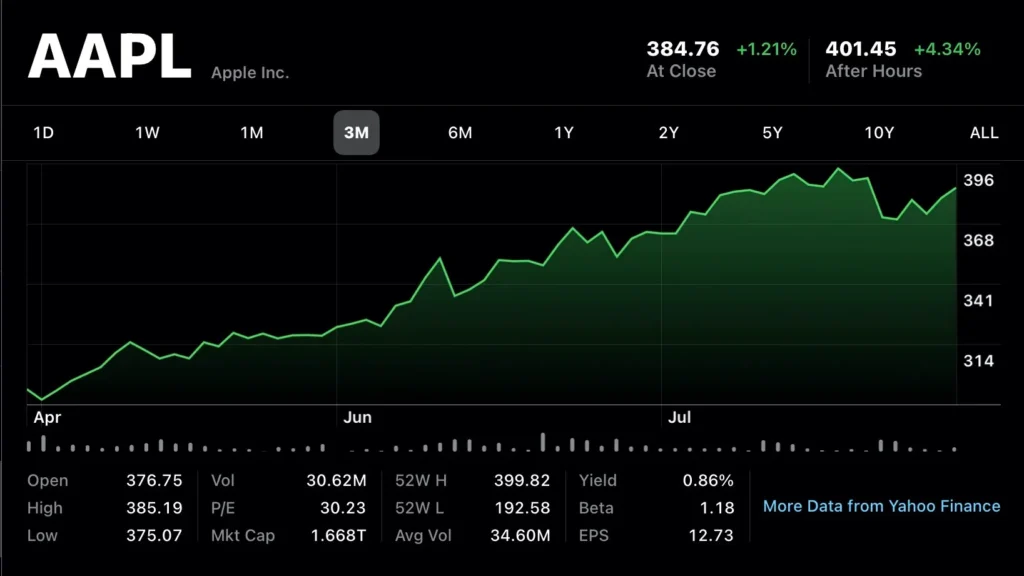Apple Inc. (AAPL), one of the most influential technology companies globally, is not only known for its innovative products like the iPhone, iPad, and MacBook but also for its significant role in the stock market. The topic of the Apple stock split has intrigued investors, financial analysts, and everyday consumers alike due to its direct impact on share pricing, investor accessibility, and broader market sentiment. This article explores the complete details of the Apple stock split, including what it means, its historical occurrences, reasons behind it, implications on the market, and what investors can expect moving forward.
What is a Stock Split?
Before diving into the specifics of the Apple stock split, it’s essential to understand the fundamental concept of a stock split. A stock split is a corporate action in which a company divides its existing shares into multiple shares to increase the number of outstanding shares. Although the number of shares increases, the company’s overall market capitalization remains the same because the value of each share is adjusted accordingly.
For example, in a 4-for-1 stock split, shareholders receive four shares for every one share they hold, but each share is worth one-fourth of the original price. This is typically done to make shares more affordable to retail investors and improve liquidity.
The History of Apple Stock Splits
Apple has executed several stock splits since it went public in 1980. Below is a breakdown of each Apple stock split and its historical context:
1. 1987 – 2-for-1 Stock Split
Apple’s first stock split occurred on June 16, 1987. For every share an investor held, they received an additional share. This was done when Apple was still in its early stages of corporate development but had already shown promise as a technology leader.
2. 2000 – 2-for-1 Stock Split
The second stock split came on June 21, 2000, during the dot-com boom. Apple’s stock was performing well due to its growing reputation, and this move was made to make the shares more accessible to a wider range of investors.
3. 2005 – 2-for-1 Stock Split
The third split was on February 28, 2005. At that time, the iPod was revolutionizing the music industry, and Apple was transitioning into a tech giant with growing consumer demand and increased profits.
4. 2014 – 7-for-1 Stock Split
This was one of the most significant stock splits in Apple’s history. On June 9, 2014, the company executed a 7-for-1 stock split, making shares much more affordable. Before the split, Apple shares were trading at over $600, which discouraged smaller investors. Post-split, each share was priced at just under $100, reinvigorating retail investment.
5. 2020 – 4-for-1 Stock Split
The most recent Apple stock split occurred on August 31, 2020. Shares were trading at around $500 before the split, and after the 4-for-1 split, each share was priced near $125. This move occurred in the midst of the COVID-19 pandemic and the surge in tech stock valuations.
Why Does Apple Do Stock Splits?
There are several reasons why Apple has chosen to implement stock splits over the years:
1. Increase Accessibility
High share prices can make it difficult for smaller investors to purchase shares. By splitting the stock, Apple lowers the per-share price, making it more accessible to a broader investor base.
2. Improve Liquidity
A lower share price typically results in higher trading volume. Increased liquidity ensures that shares can be bought and sold more easily, which benefits both the company and its shareholders.
3. Investor Psychology
There’s a psychological component to stock splits. Investors perceive a lower share price as more affordable, even though the actual value of the company hasn’t changed. This often attracts new retail investors and boosts confidence in the stock.
4. Signaling Confidence
Executing a stock split often signals a company’s confidence in its continued growth. Apple’s repeated stock splits have historically followed strong performance periods and have often preceded further gains.
The 2020 Apple Stock Split: A Closer Look
The Apple stock split of 2020 came during an unprecedented time in global markets. With much of the world in lockdown due to COVID-19, technology companies experienced increased demand and stock market rallies. Apple’s performance during this time was stellar, bolstered by strong sales and a growing services segment.
Key Details:
- Date Announced: July 30, 2020
- Split Ratio: 4-for-1
- Record Date: August 24, 2020
- Effective Date: August 31, 2020
- Pre-Split Price: ~$500
- Post-Split Price: ~$125
This move not only increased the stock’s affordability but also positioned Apple for inclusion in portfolios that track the Dow Jones Industrial Average, which is price-weighted and had previously underrepresented Apple due to its high share price.
Effects of the Apple Stock Split

1. Market Performance
Following previous splits, Apple shares have generally seen a positive trend. The 2020 split led to a temporary price surge as retail investors flocked to buy the now “cheaper” shares.
2. Retail Investor Interest
Platforms like Robinhood saw a surge in Apple stock purchases post-split. The accessibility allowed young and first-time investors to own a piece of the tech giant.
3. Option Trading
Options contracts became more accessible after the split since the strike prices were lowered, enabling smaller investors to engage in options trading with lower capital requirements.
4. Stock Index Adjustments
Due to the price change, Apple’s weight in certain price-weighted indices like the Dow Jones was adjusted, which influenced broader market metrics.
Will Apple Split Its Stock Again?
While there’s no official confirmation of another Apple stock split, several factors may prompt one in the future:
- If Apple’s share price climbs above $300–$400 again
- To maintain affordability for the average investor
- To increase participation from retail traders
- To keep Apple’s shares competitive with peers like Amazon, Google, and Microsoft
As of now, Apple is exploring new sectors such as artificial intelligence, services, and augmented reality, all of which could propel its valuation even higher, potentially leading to another stock split in the coming years.
Investment Perspective: Should You Buy After a Stock Split?
Many investors wonder whether a stock split is a “buy signal.” While a Apple stock split itself doesn’t increase intrinsic value, it can indicate strong company health and investor confidence.
Pros of Buying After a Split:
- Increased affordability
- Psychological momentum
- Broader investor interest
- Signal of continued growth
Cons:
- No fundamental change in value
- Potential short-term volatility
- Stock may already be priced for perfection
Ultimately, investment decisions should be based on fundamentals — earnings, revenue growth, innovation, and market position — rather than stock splits alone.
Conclusion
The Apple stock split is a significant event that underscores Apple’s ongoing success and investor-friendly approach. Over the decades, Apple has used stock splits not only to enhance accessibility and liquidity but also to demonstrate confidence in its long-term performance. While a stock split doesn’t alter the company’s value, it plays an important role in market dynamics and investor sentiment.
With its rich history of innovation, growing services segment, and dominant market presence, Apple remains a cornerstone in many investment portfolios. Future splits may occur if Apple’s share price continues to rise, and if they do, history suggests they may again be followed by sustained interest and growth.
FAQs
1. What is a stock split in simple terms?
A stock split increases the number of shares outstanding while reducing the share price proportionally, making the stock more affordable without changing the company’s total value.
2. How many times has Apple split its stock?
Apple has split its stock five times: in 1987, 2000, 2005, 2014, and 2020.
3. What was the most recent Apple stock split?
The most recent split was a 4-for-1 stock split executed on August 31, 2020.
4. Does a stock split affect my investment value?
No, your total investment value remains the same. You just own more shares at a lower price.
5. Should I buy Apple stock after a stock split?
A stock split may make the stock more affordable, but it’s important to evaluate the company’s fundamentals and growth potential before investing.
6. Is another Apple stock split expected soon?
There’s no official announcement, but if the stock price continues to rise significantly, another split is possible.
7. How do I receive new shares after a split?
If you own Apple shares before the record date, the new shares are automatically credited to your brokerage account based on the split ratio.
Also read: DJT Stock Price Prediction 2025



Pingback: Zyn Shortage: Understanding the Causes, Impact, and What Comes Next - NYWeeklys